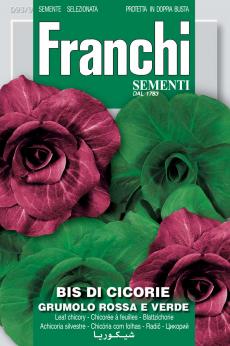
Bis Di Cicorie Grumolo Rossa e Verde - Cicoria Red and Green Mix
Bis Di Cicorie Grumolo Rossa e Verde
Mid/early ancient leaf chicory that you 'cut and it comes again'. Forms the beautiful characteristic rosette-shaped heads late in the season with the cold. Sow 1cm in depth from spring to autumn and harvest during the winter months. Looks spectacular when used in a salad dish. 12g approx 6000 seeds
Radicchio ( Cicoria) has been around for centuries. Pliny, the elder makes mention of the red-lined lettuce of the Veneto region noting that not only was it tasty the leaves could also cure insomnia and purify the blood.
The modern radicchio with its rich red and white leaves was developed in the mid 1800's.Today, radicchio is the generic name of a few types of leaf chicory. There are many kinds but the most famous and important are Rosso di Treviso, Variegata Di Castelfranco.These have IGP status
Both red and green cicoria thrive in cooler temperatures and can tolerate frost.Mostly red and green cicoria is used torn and raw; when cooked the bitterness is less pronounced and changes to an autumnal red-brown and develops the trademark nutty flavour
Heading chicory and radicchio initially grow a mass of loose leaves that in time will head up.
Chicory has no particular climatic needs, it likes a few hours of sun a day and is able to resist even very cold temperatures. We can find chicory up to 1200 meters above sea level, but also along paths, uncultivated or cultivated land, stony or rubble-covered land, etc.
Chicory reproduces by seed. The sowing period is different depending on the variety: if we grow cutting chicory, the sowing will be done by broadcast and it will be possible to do it all year round, trying to avoid moments with very cold temperatures; if the chicory grown is from the head, we will sow in April or May directly into the ground, in the seedbed until the month of August. Before proceeding with sowing, the soil must be worked to a certain depth and fertilized with mature manure and mineral fertilizer. When the new seedlings have developed about ten leaflets, they will be ready to be transplanted at a distance of about thirty centimeters from each other and forty centimeters between one row and another. To have very compact and crunchy heads you will have to proceed with forcing, which consists of cutting the young roots and covering them with damp earth inside a container. After about thirty days you will have very crunchy white leaves.
WATERING / FERTILIZING
Chicory requires a good supply of regular and constant water. Before sowing, the soil must be fertilized with mature manure. During the development phase of the seedlings it will be advisable to administer a nitrogen fertilizer.
TYPE OF SOIL - REPOTTING
Chicory doesn't ask for much: it adapts to various types of soil, calcareous, siliceous, etc., the important thing is that it has a very good drainage system.
